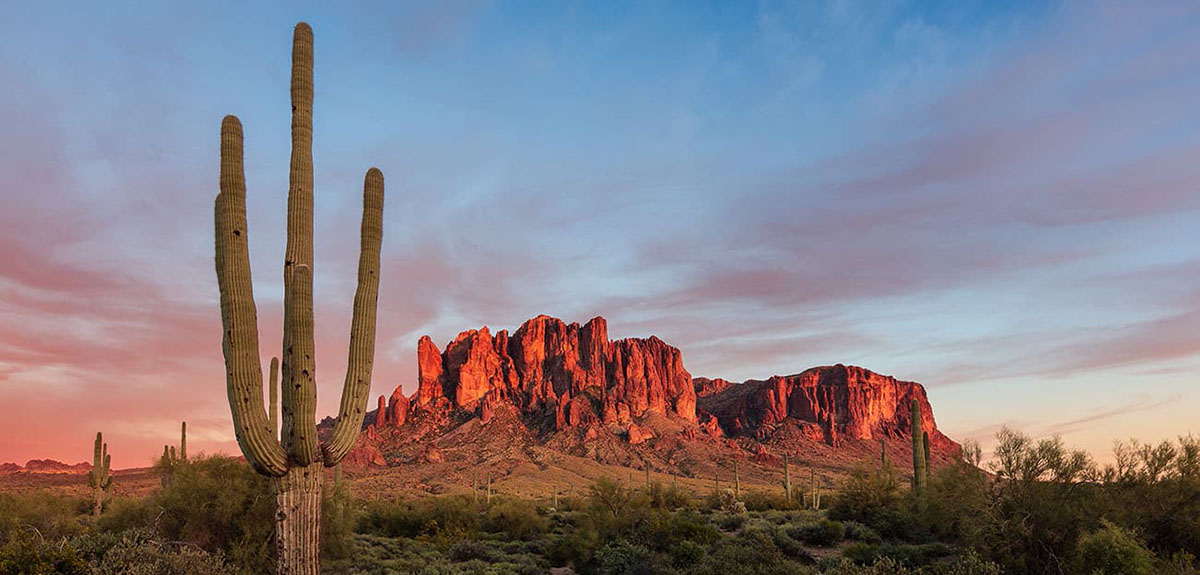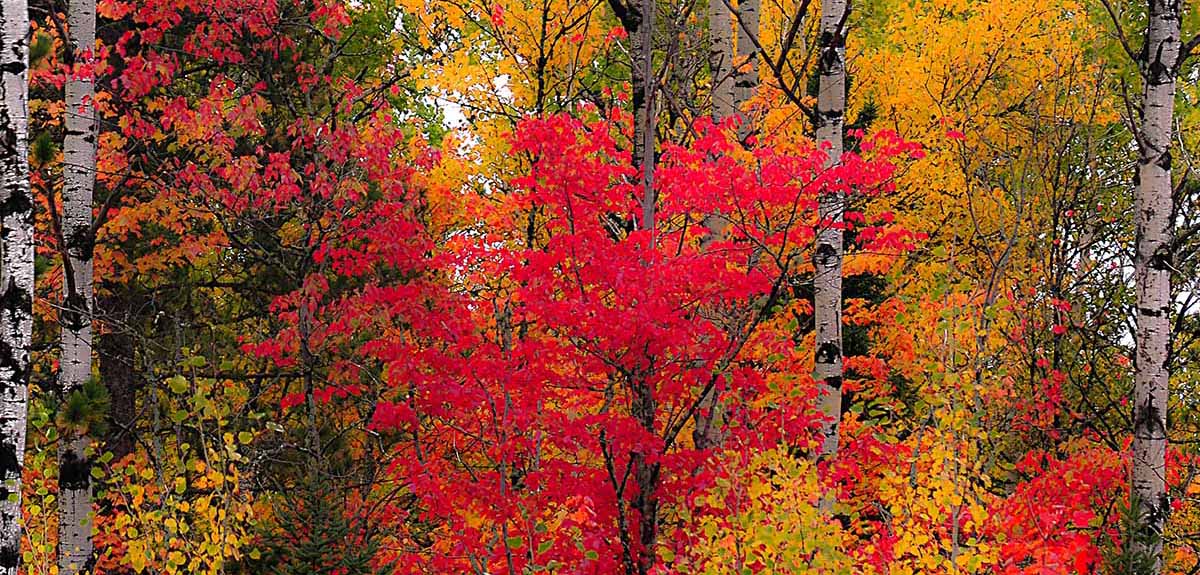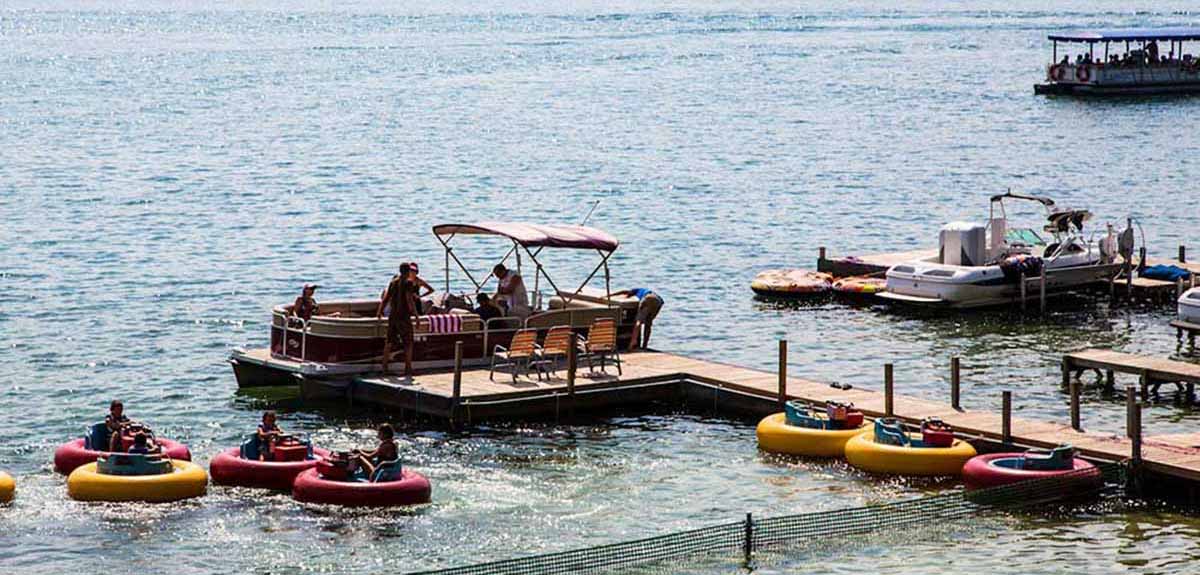Three Forks, Montana in a Winnebago
Image Caption:
His name was Clyde. In my 20 years of education, he was the only fellow student who offered me fresh macadamia nuts as a snack. I met Clyde, a native Hawaiian, while attending graduate school in Kentucky. To me, his childhood home seemed exotic and idyllic. How magical it must be to live year-round on an island that most people visit as a holiday destination. But Clyde’s attitude toward his homeland was different. When he spoke of Hawaii, it was in terms of family and friends rather than beaches and surfboards. It almost seemed as if he failed to appreciate his roots in relation to the world of leisure travel.
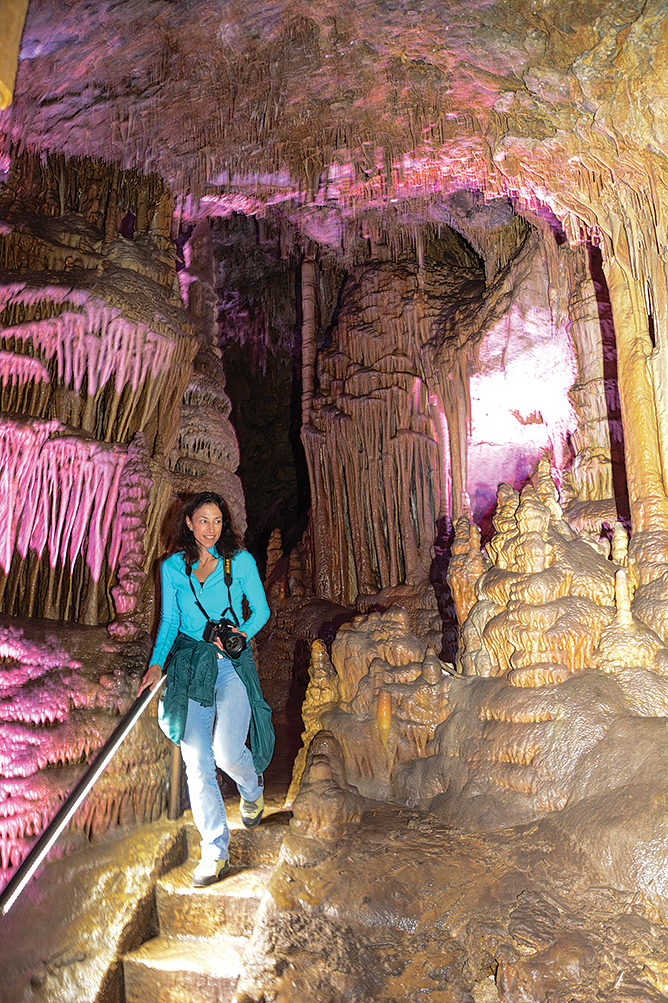
Lewis and Clark Caverns is one of the most highly decorated limestone cave systems in the world.
In reality, I can’t be too hard on Clyde. Three Forks, Montana, was the “urban” center of my childhood, which occurred more specifically on a ranch west of town. A bedroom community of sorts to Bozeman, and a back door to Yellowstone National Park, Three Forks is a fascinating playground of history and recreation, but seldom appreciated in its own right due to its proximity to attractions more centrally focused in the national spotlight. As a kid, I didn’t think much of my hometown and its surroundings. As a well-traveled adult, it now has more esteem in my mind.
When a pretty girl from New Hampshire accepted my marriage proposal a couple of years ago and moved west, it set the stage for a visit to the Three Forks area. Lisa was curious about my old stomping grounds. On a blushing day in August, we hit the road to my hometown in a peppy Winnebago Trend, an RV perfectly suited for our journey.
The Three Forks Fly-In is an annual event bringing vintage and unusual aircraft to Pogreba Field, the local airport. Nearing its 40th anniversary, the annual gathering occurs August 6 through 8 this year. Planes begin arriving on Thursday for the three-day reunion. Saturday is the highlight, with pilots vying for top honors in contests that include precision landing and “flour bombing,” a crowd favorite in which two-person teams fly over a runway attempting to manually drop a sack of flour into a barrel below.
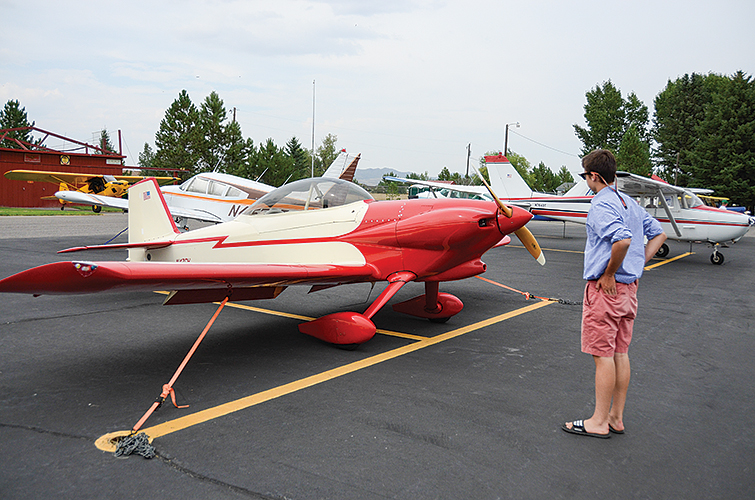
Each August the Three Forks Fly-In brings scores of vintage airplanes to the town, where onlookers of all ages are intrigued by the rare aircraft.
We hit the fly-in late Friday afternoon. Most of the flying was done for the day, but an array of intriguing aircraft was parked on the tarmac. Many pilots lounged by their craft or mingled with onlookers.
A sleek wooden airplane caught our eyes. It appeared very old, but unlike most of the planes that seemed engineered for just a couple of occupants, this plane had a row of windows and was larger than many on the field. It had reddish-orange wings jutting from the top of the glistening black fuselage that looked to be made of wood. The words “Travel Air” were embossed on its tail and just behind the engine in a flowing script.
As we circled the plane, admiring its unique lines and speculating about its origin, the pilot stepped forward to greet us and asked if we’d like a peek inside. Hank, who is from Kalispell, Montana, explained that the Travel Air 6000 was built in the late 1920s. Delta Air Service (now Delta Air Lines) bought three of the planes and began its first commercial air service between Dallas, Texas, and Jackson, Mississippi.
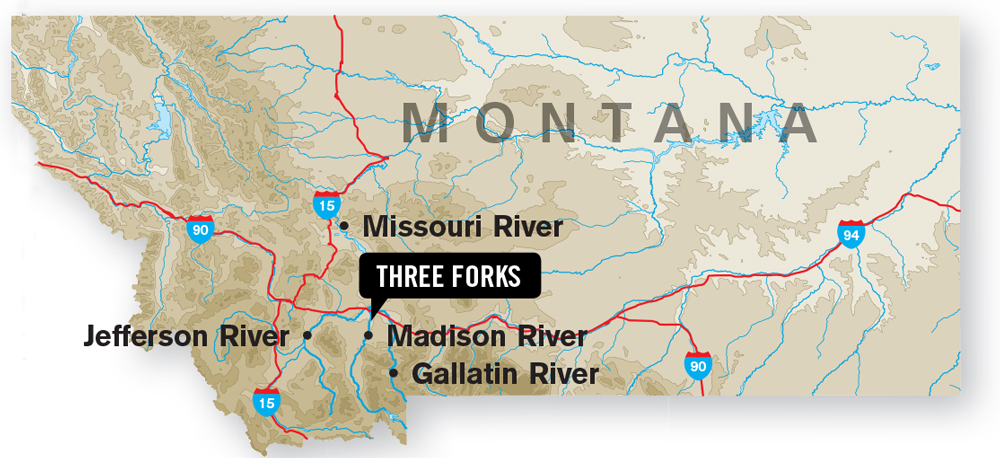
Inside, we marveled at the beautiful wicker seats for six passengers. Hank urged Lisa to sit in the pilot seat. He offered another tidbit of the plane’s history, noting that the Travel Air did not last long as a commercial passenger plane, ousted from the fledgling market by faster models not long into the 1930s.
Toward sunset, after viewing dozens of other interesting aircraft, we pointed the grille of the Trend toward the campground at Missouri Headwaters State Park. The park is located less than 5 miles from Three Forks on a route I know well. When I was in high school, the track coach sometimes herded our entire team onto a bus, drove us to the park, then dumped us with orders to run back to school.
We found the campground toward the south end of the park, vastly improved from the days of my youth. A rentable tepee lent a historic air to the bivouac near the entrance. Not far beyond the tepee was an area for outdoor games. Moments later, we slid the Winnebago into our reserved site, prepared dinner, then took Percy, our English setter, for a stroll around the campground.
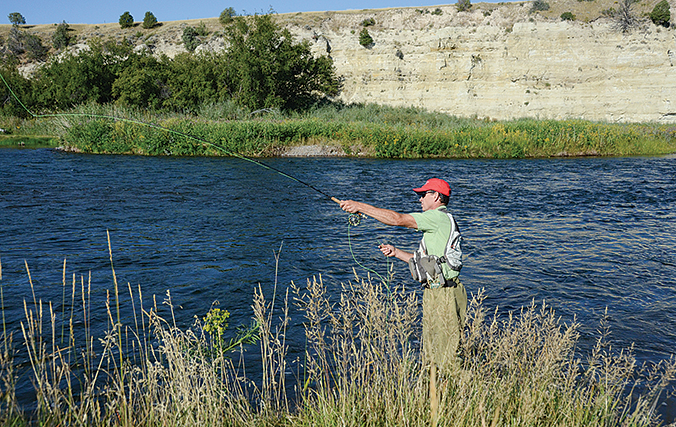
The author casts for trout on the Madison River, not far from Three Forks. The area boasts excellent fishing on a variety of streams.
Missouri Headwaters State Park sits in a broad valley with towering mountain ranges visible in nearly any direction. Despite its setting, the park’s history is perhaps its primary attraction. One of the goals of the Lewis and Clark Expedition was to discover the source of the Missouri River. Within the 532-acre boundary of the park, the Madison, Gallatin and Jefferson rivers twine to form the Missouri. On July 25, 1805, the Corps of Discovery reached the ground upon which Missouri Headwaters State Park is located. They spent five nights at the headwaters, the captains wishing to scout ahead and rest the men before pushing forward into what they described as intimidating surroundings of vertiginous mountains and hot, unshaded valleys.
The following day we left on foot from our campsite, leashed animal companion in tow. A walking path led from the campground to Fort Rock, an elevated mound of limestone located between the Gallatin River and the confluence of the Jefferson and Madison rivers. It’s an easy 1-mile hike from the campground to this unique geological feature that received its moniker from a comment Meriwether Lewis made in his journal regarding its potential as a fortified outpost. The level path turned to a quick scramble, as we made our way to the top of the rock.
“Wow.”
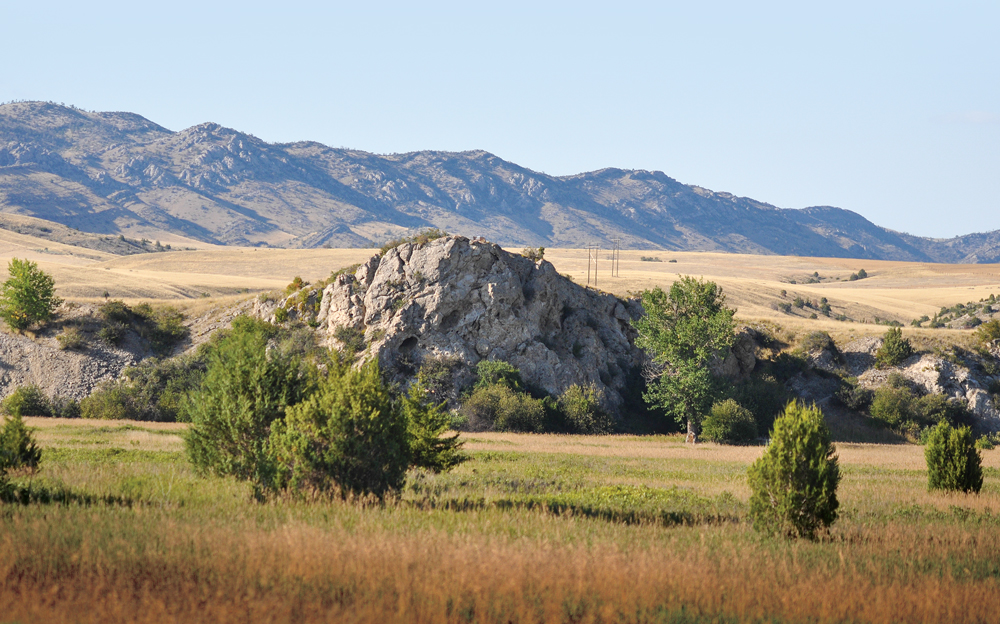
Named by Captain Meriwether Lewis, Fort Rock (in the foreground)
is one of the attractions at Montana’s Missouri Headwaters State Park.
My sweetheart’s words caught me by surprise. I glanced sideways to view an intense sense of wonderment on Lisa’s face. Overwhelmed by a view I’d seen many times (one of my summer jobs off the ranch was as a part-time caretaker at the park), she prompted me to breathe deeply and take a fresh look at the scene. To our right, the Gallatin River snaked through the valley, its glistening watercourse flanked by towering green sentinels, massive cottonwood trees whose leafy canopies sway in the summer breeze. Before us, the Gallatin joined the other two melded forks of the Missouri. So taken with the significance of the location, Lewis and Clark recorded with painstaking care their survey of the country and sketched a map for reference.
Our return route to the campground included a side trip to an interpretive site at the confluence of the Jefferson and Madison rivers, the spot commonly accepted as the headwaters of the Missouri. One sign recounted the story of Sacagawea, an American Indian woman who served as a guide and interpreter for the expedition after joining Lewis and Clark with her husband in the Dakota Territory. Sacagawea was kidnapped into slavery at this site much earlier by a raiding band of Hidatsa Indians. Her knowledge of the surrounding country and reunion with her familial tribe, the Lemhi Shoshone, was to prove pivotal in the success of the expedition, as it traversed the rugged mountain territory west of Three Forks.
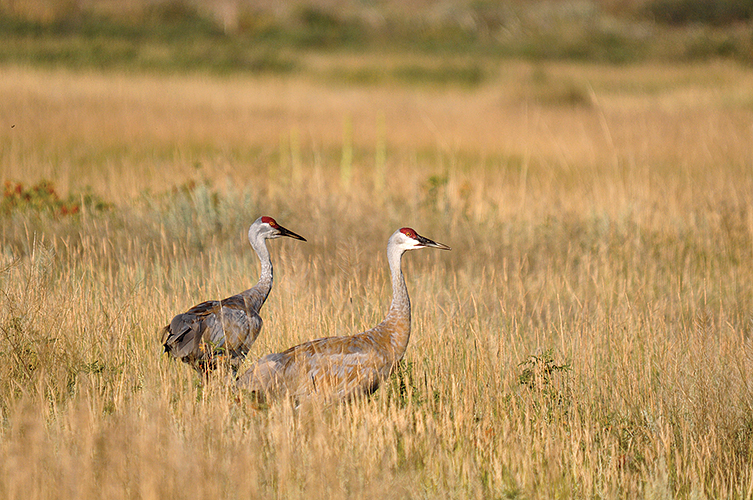
The area abounds with many species of birds and other wildlife, including sandhill cranes that wander the grasslands west of Three Forks.
Leaving the headwaters, we motored west in roughly the same direction taken by Lewis and Clark more than 200 years previously. Our destination was Lewis and Clark Caverns State Park, home to one of the most highly decorated limestone caverns in the world. As we drove happily along the highway, views of the Tobacco Root Mountains and the Jefferson River captured my wife’s gaze and necessitated several stops for photos. The entrance to the park came just a half-hour after we lunched at a city park on the outskirts of Three Forks. A winding road leads from the park’s entrance to the visitor center. Leaving a narrow plain along the Jefferson River, we climbed quickly through a series of canted ravines, smattered with pale limestone formations poking among dark stands of aromatic Douglas fir trees.
The highlight of this state park is a guided tour of the caverns. As we hiked from the visitor center to the entrance of the cave, I wondered aloud how much of the tour I would remember from my days as a tour guide some 35 years earlier. We passed through the underground labyrinth of naturally sculpted limestone at the back of the group, Lisa savoring the geology lessons imparted by the guide and peering at the colorful array of formations.
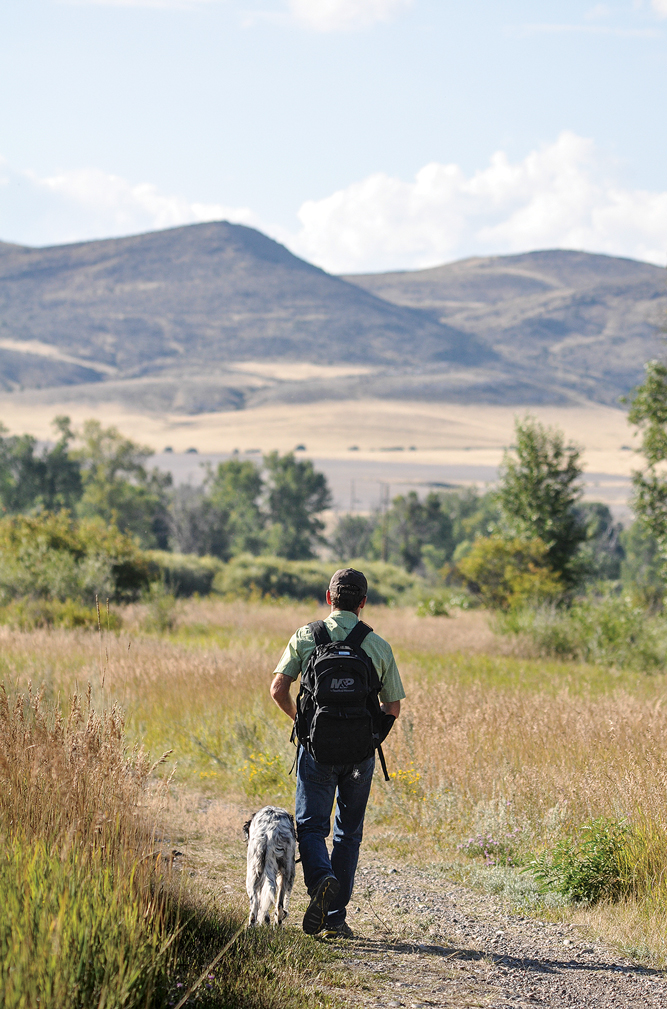
Hiking trails at Missouri Headwaters State Park, with level paths, are the perfect way to get around for novice and experienced hikers alike, and are dog-friendly to pets on a leash.
My memory piqued by the surroundings, much of what I’d forgotten about the cavern returned in a veritable flood. Our guide made jokes about many unusual formations including a stalagmite in the shape of a frog. I smiled with zipped lips, remembering the punch line to each witticism, reliving a snippet of my early adulthood with a renewed appreciation for the natural wonder that supplied me employment and savings for college.
Exiting the cave, we blinked owlishly in the late-afternoon sunshine. Halfway down the walking trail to the visitor center, we stopped to admire the view. The Jefferson River wove through the vale below in a silver ribbon. Hollowtop Mountain, the highest summit in the Tobacco Root range, thrust its pate above the lowlands, replete with a crescent snowbank just below its open, rocky top.
“Nice place to grow up,” murmured Lisa, as she looked around.
It was. Decades later, the Three Forks area holds even greater charm for me as an adult than it did as a kid.
Lewis and Clark Slept Here
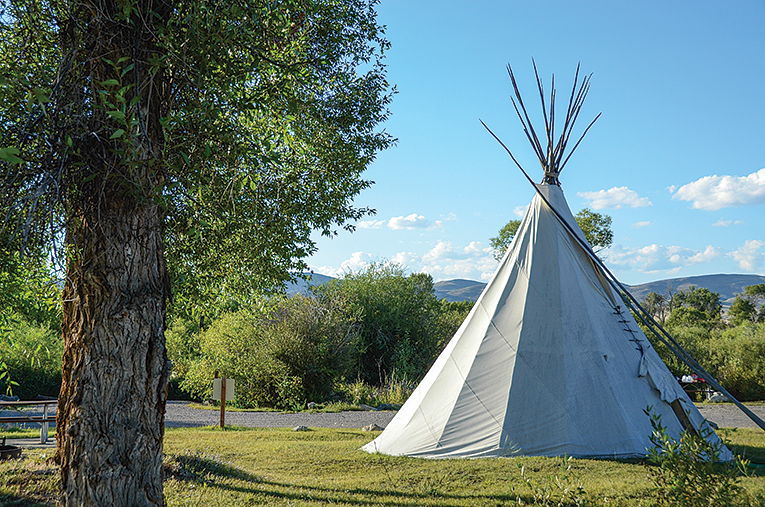
A tepee lends a historical aura to the campground at Missouri Headwaters State Park. Visitors looking for a unique camping experience can rent the American Indian-inspired lodging.
Meriwether Lewis and William Clark wrote extensively in their journals while camped at the headwaters of the Missouri. Here are some of the things they had to say:
Words from Lewis and Clark
“Both Capt. C. and myself corrisponded in opinion with rispect to the impropriety of calling either of these streams the Missouri and accordingly agreed to name them after the President of the United States and the Secretaries of the Treasury and state… In pursuance of this resolution we called the S.W. fork, that which we meant to ascend, Jefferson’s River in honor of [that illustrious personage] Thomas Jefferson. The Middle fork we called Madison’s River in honor of James Madison, and the S.E. Fork we called Gallitin’s River in honor of Albert Gallitin.” — Meriwether Lewis, on naming the three forks of the Missouri River
“Between the middle and S.E. forks near their junctions with the S.W. fork there is a handsom site for a fortification it consists of a limestone rock of an oblong form; its sides perpendicular and about 25 ft high except at the extremity towards the middle fork where it ascends gradually and like the top is covered with a fine terf of greenswoard.” — Meriwether Lewis, describing Fort Rock
“The beds of all these streams are formed of smooth pebble and gravel, and their waters perfectly transparent; in short they are three noble streams.” — Meriwether Lewis
“Our present Camp is the prosise Spot the Snake Indians were Camped at the time the Minetarries came in Sight, attacked & killed 4 men 4 women & a number of boys, & made prisoners of all the females & 4 boys.” — William Clark, describing the capture of Sacagawea
WHERE TO EAT IN THREE, FORKS
Land of Magic Steakhouse
Located on the I-90 frontage road in a little spit of a town (Logan), just five minutes east of Missouri Headwaters State Park, this restaurant is a local favorite for all things beef.
Sacajawea Hotel
“The Sac,” as it’s known locally, is a picturesque, historic hotel in Three Forks. Pompey’s Grill, located in the hotel, is named in honor of Sacagawea’s son. It offers excellent dining in a classic setting.
Wheat Montana Bakery and Deli
We never drive through the area without stopping for coffee and a pastry at Wheat Montana, where locally grown grains are milled into flour and baked into scrumptious cinnamon rolls, breads and other goodies. Located at the intersection of I-90 and U.S. Highway 287, just a few miles west of Three Forks.
WHERE TO CAMP
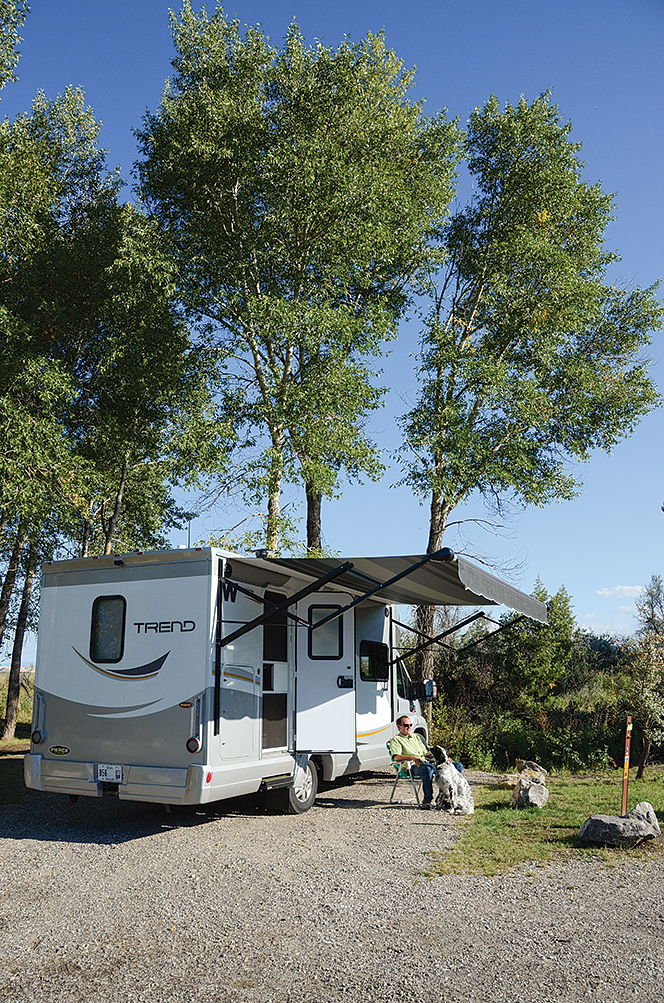
Relaxing at the campground at Missouri Headwaters State Park. Reserve in advance to ensure you get a spot at this historic place.
Bear Canyon Campground
Thirty miles away in Bozeman, Bear Canyon is open May 1 through October 1 and has full RV hookups, an outdoor heated pool, free Wi-Fi, scenic mountain views and easy access to outdoor activities.
Camp Three Forks
Open May 21 to September 15, Camp Three Forks offers full RV hookups, laundry facilities, a playground, a gift shop and high-speed Internet.
Lewis and Clark Caverns State Park
Located 17 miles west of Three Forks, the year-round park has 25 campsites, including some with electric hookups, for RVs of varying lengths. Tours of the caverns are available daily, May through September.
Missouri Headwaters State Park
Open year-round, the park has historical exhibits, hiking trails and 16 primitive campsites for RVs of varying lengths. Lewis and Clark camped here in 1805, and you can too.
FOR MORE INFORMATION on Three Forks, Montana
Three Forks Chamber of Commerce
Information on local events and attractions including golfing, fishing, canoeing and historic sites.

